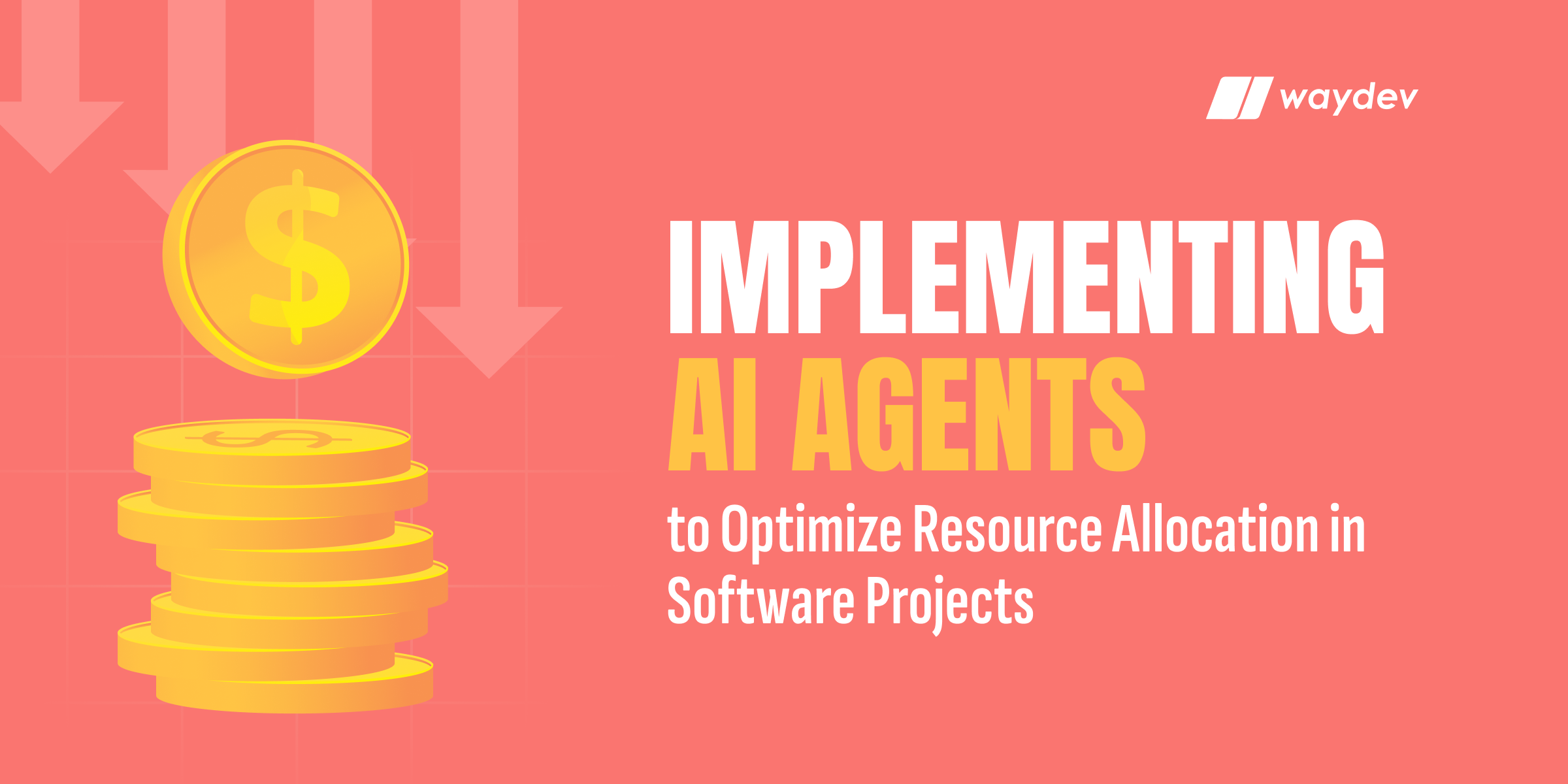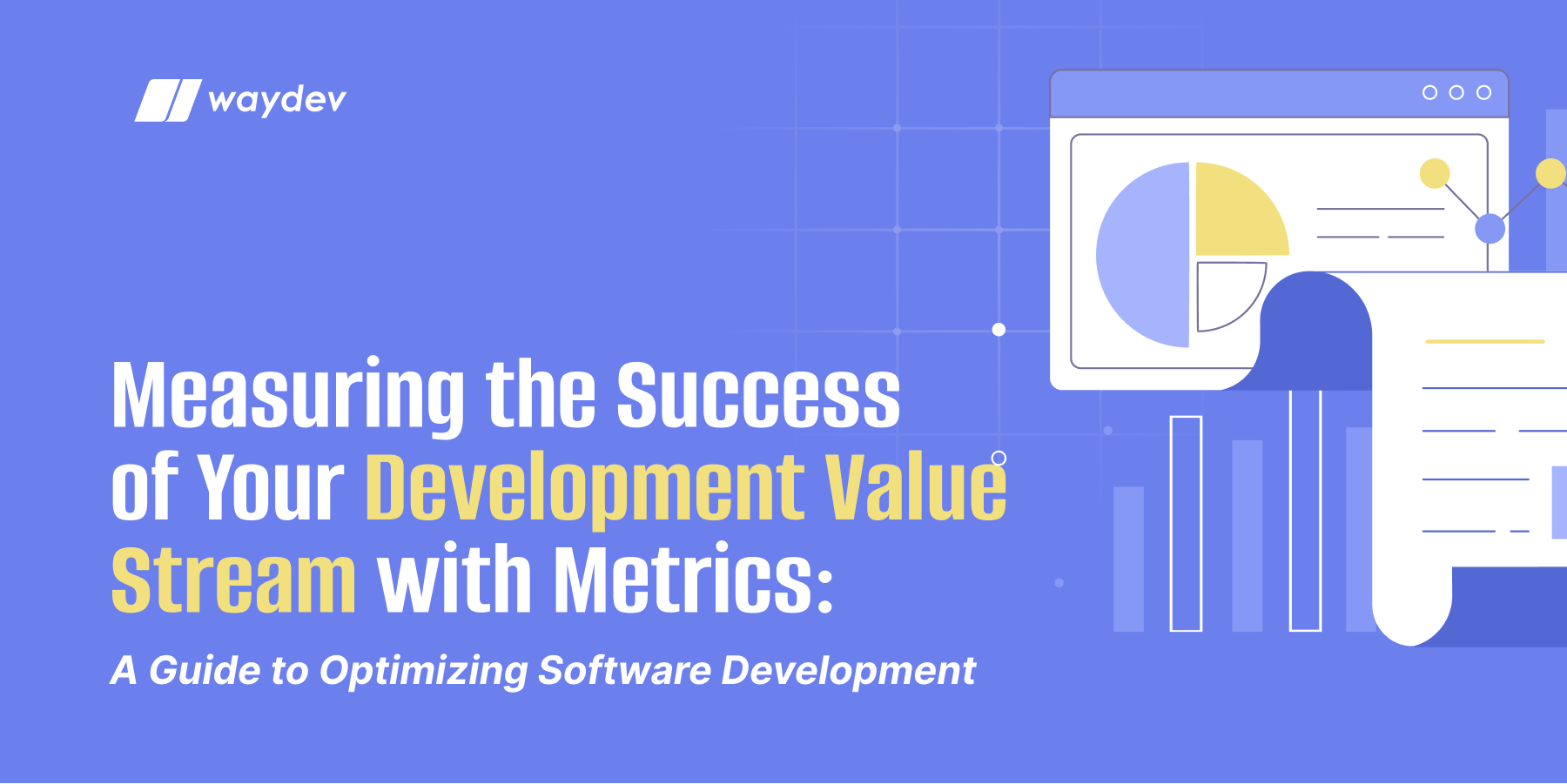Value Streams are a fundamental part of the Scaled Agile Framework (SAFe) that integrates the workflow patterns of Lean-agile teams. SAFe came about to give tech organizations better solutions for project management that encourage efficiency, collaboration, and a better approach to scaling agile projects.
In this article, we will focus on the Development Intelligence Value Stream, a crucial component of SAFe that helps measure team performance and delivers value to customers. Organizations can optimize their Development Intelligence Value Stream for better efficiency and effectiveness by understanding the processes involved and using the right tools and metrics.
In a software development environment, Waydev is a powerful solution that enables tech executives to follow specific metrics that better understand overall performance, workflows, and what it takes to deliver value to customers. By keeping an eye on this data through complex dashboards, you, as a tech executive, can make better decisions that align with business goals and the overall technological vision of your organization.
Definition of Development Intelligence Value Stream
Value streams refer to the steps taken to convert a business idea into a deliverable product for customers. The concept originated in 1990 when James Womack, Daniel Jones, and Daniel Roos defined value streams as a series of activities performed by an organization’s teams in order to deliver value to customers. It was later associated with Lean thinking, a framework that focuses mainly on customer satisfaction.
In software development, this concept translates into Development Intelligence Value Streams (DVS), and the goal is to create value streams that turn customer requests into digitally-enabled solutions. These solutions provided through DVS may be for internal use or for external use. To prioritize which software projects are most important and need to be completed first, you need a way to understand and evaluate your Development Value Stream. For instance, a large bank’s tech department might develop software products both for internal use, support the bank’s employees, and for external use, such as customer-facing home banking apps. By optimizing the Development Value Stream, tech executives can prioritize projects, deliver value quickly, minimize resource waste, and make data-driven decisions to meet business goals and deliver customer satisfaction.
Implementing Value Streams within your organization means approaching project management in a new and revolutionary way, where teams have clear steps in mind in order to create value for customers. In this model, work is performed in small batches that are clearly organized in specific steps, and collaboration and communication between different teams and departments are highly encouraged. This results in better and faster output, as opposed to working in silos where teams are isolated and less organized.
Development Value Stream vs. Operational Value Stream
Scaled Agile Framework includes two types of Value Streams: Development Value Streams (DVS) and Operational Value Streams (OVS). While both focus on delivering value for customers, there are some differences between them, as DVS improves the systems that OVS needs to deliver results directly to customers.
Development Value Streams include the people and steps necessary to convert a customer request into a digitally-enabled solution. In other words, a DVS includes a trigger and value – a customer request triggers it (this will enroll the process of defining the solution, building, validating, and then releasing it), and it delivers value.
Operational Value Streams are centered on delivering end-value to customers based on the solutions created through the Development Value Streams. They speak to the flow of your business and continue to provide end-user value for as long as the organization produces a certain product or service. Four main categories fall under Operational Value Streams. These categories often involve more than one department at a time, so collaboration and efficient workflow are highly encouraged.
- Fulfillment Value Streams – refer to the steps taken to deliver a customer request.
- Manufacturing Value Streams – entail taking prime matter and manufacturing a product for the end-customer.
- Software Product Value Streams – software products used directly by customers and the support offered.
- Supporting Value Streams – refer to steps taken to support ongoing activities.
DVS and OVS are strongly interlinked and depend on each other to continuously add value to customers. Development Value Streams are the backend systems that keep Operational Value Streams functional, providing the solutions needed for the latter to function or to deliver products or services to customers.
Importance of Development Value Stream in Modern Software Development
Mapping DVS through the SAFe framework gives you clear visibility of all the value streams in motion throughout the organization, how they work together, and where dependencies lie. Implementing DVS allows not only to clearly see what’s needed to move an idea through the development lifecycle, but the measured data also helps improve the deployment processes by identifying bottlenecks and sources of delays.
Well-organized development value streams give you the chance to organize projects in a more efficient way while keeping business goals in mind. Implementing DVS is important in tech organizations, bringing many advantages, such as:
- It produces faster delivery time to market with work being organized in small batches.
- It encourages cooperation between teams which can improve overall efficiency and workflow.
- It comprises more stable teams that work on projects for longer periods and are focused on continued learning and on delivering value.
- It helps tech leaders identify bottlenecks or roadblocks by assessing workflows that might cause delays and inefficient usage of resources.
- It helps tech executives assess performance by providing complex visibility on the delivery processes. This allows implementation changes where they are needed for continuous improvement of the product delivery pipeline.
Impact of the DVS on Business
The development value stream is a critical component of a business’s ability to deliver value to customers and achieve its objectives. Optimizing the development value stream can help a business to be more efficient, effective, and competitive. Other intrinsic benefits of using DVS to scale your business include the following:
- Speed to market – customer requests will be met faster when aligning cross-functional agile teams around value.
- Cost efficiency – scaling your business on a backbone of development value streams provides a better global view of resource planning and usage along the way, instead of seeing the ROI only after release.
- Product Quality – by streamlining development processes, reducing waste and errors, and promoting collaboration and continuous improvement.
- Business agility – implementing development value streams within your organization is a powerful means of achieving business agility.
- Customer satisfaction – DVS is focused on delivering better quality products to customers in a faster way so customer satisfaction will increase incrementally.
Integrating DVS with DevOps Practices
Integrating Development Value Stream (DVS) with DevOps practices can lead to a more streamlined, efficient, and effective development process. DevOps principles such as continuous integration and continuous delivery, automation, and collaboration between development and operations teams can be integrated into the DVS to improve speed to market, cost efficiency, and product quality.
Waydev can contribute to this integration by providing valuable insights and metrics into the development process. It can help identify areas for improvement and track progress, enabling organizations to continually optimize their DVS and DevOps practices. The powerful analytics and visualization capabilities of Waydev can help drive collaboration between teams and make informed decisions to achieve business goals and improve customer satisfaction.
Development Value Streams Stages
Development Value Streams organized within SAFe include a sequence of activities that happen in certain stages and the elements they involve:
- A customer (internal or external) gives a new feature request that triggers the Value Stream.
- A solution is found by moving from defining the key to building, validating, and releasing it to be tested in a customer environment.
- In between these steps, there are other elements such as the specific value added by each team member that works on this request.
- The time it takes from the initial request to the value release is called lead time.
Development Value Stream and the SAFe Principles
The Scaled Agile Framework provides an organized and well-structured framework for agile teams to function better and more efficiently. The SAFe practices are based on a number of core principles that encourage better decision-making at an executive level.
1. Take an Economic View
When it comes to Development Value Stream (DVS) in the Scaled Agile Framework (SAFe), the economic view plays a key role in ensuring success. The goal is to deliver value to customers most efficiently and cost-effectively, which means considering factors like development costs, manufacturing costs, and operational costs, as well as the time it takes to release a product or feature.
A solid understanding of economic principles and resource planning, as well as following the originally approved budget, is crucial for optimizing the DVS. SAFe’s first principle emphasizes the importance of having a solid economic view that informs all executive decisions and guides the entire development process. This approach helps ensure that the DVS is aligned with the organization’s objectives and provides maximum value to customers.
2. Apply Systems Thinking
This approach enables organizations to understand the interdependent relationships between various components, including the development team, tools, processes, and end customers. By considering all aspects of the development process, organizations can identify areas for improvement, streamline workflows, and optimize the DVS.
3. Assume Variability; Preserve Options
When we are in the business of developing new technologies and features, there are no beaten paths to go on that result in guaranteed success. While it is tempting to reduce variability as much as possible, this 3rd SAFe principle tells us that variability also means keeping more options open. In other words, if you begin the development process with only one design option, though it may seem the safer way to go, this can limit your options and design quality later on.
4. Build Incrementally With Fast, Integrated Learning Cycles
The development process is prone to errors and financial risks. Until you deliver new features in a customer environment, there’s little to indicate if you have a successful design and proper functionality. But Lean principles enable a different approach that allows reducing risks by building solutions incrementally in short iterations. Using integration points provides earlier customer feedback and knowing if the current design choice is both feasible and sustainable.
5. Base Milestones on an Objective Evaluation of Working Systems
Software development in the modern-day era often entails substantial financial investments, but you need the proper tools and knowledge to understand if they will pay off instead of going on wishful thinking until deployment. Lean-agile development bases its practices on constant evaluation throughout the development life cycle using integration points. They measure each milestone to determine whether the system will work properly and return the initial investment.
6. Visualize and Limit Work in Process (WIP), Reduce Batch Sizes, and Manage Queue Lengths
The SAFe framework improves workflow and encourages faster output. This can be accomplished by limiting the amount of Work in Progress (WIP) within the development value streams to a reasonable amount that can be easily managed, organizing work in smaller batches that will be done faster and with fewer bottlenecks, and managing queue lengths (this will reduce delays, improve general flow and deliver more predictable outcomes).
7. Apply Cadence, Synchronize With Cross-Domain Planning
By applying cadence and synchronization to your development process you will reduce the uncertainty factor that comes with the territory in software development. Cadence gives you a steady rhythm in the development process and improves new work waiting time predictability. Synchronization means understanding multiple perspectives, many events happening, and being integrated simultaneously.
8. Unlock the Intrinsic Motivation of Knowledge Workers
Understanding how to better motivate employees will unlock better workflow, innovation, and an overall more dynamic work environment that is prone to cooperation. This principle of Lean-agile development tells us that you can do so by unlocking the worker’s intrinsic motivation, limiting constraints, and providing autonomy.
9. Decentralize Decision Making
In a tech organization, both global decisions and more local ones occur at the same time. While some decisions imply a more general view of the business and can only be made at the highest executive level, others need to be decentralized and made by the ones closest to a specific department.
10. Organize Around Value
The older approach to software development required organizing your practices around functional expertise. But the modern-day development process imposes a much more dynamic work approach that focuses on the value you can deliver to the customer as fast as possible.
Why Should You Implement SAFe in Development Value Streams?
Using Development Value Streams in SAFe Frameworks has many benefits, such as improving your workflow, velocity time in delivering value to customers, and ultimately to your entire organization. Value Stream Mapping can streamline operations across all business activities and improve team collaboration. All of this results in creating better work culture, increased productivity, and better return on investment.
How to Track and Monitor Performance Of Development Value Streams
Once you’ve implemented Development Value Streams, you also need to keep track of them, learn how multiple ones influence each other, and assess their performance. You can use specific metrics to measure progress and identify bottlenecks that cause delays and the impact of changes over time. By using dashboards, you can monitor metrics such as throughput, lead time, or cycle time, gain a global view of how the Value Streams are performing in real-time, and make adjustments as you go.
Waydev is a powerful solution that provides comprehensive data that you can use to track value streams throughout your entire tech organization. The available metrics displayed on complex dashboards give you a broader understanding of the development process, where improvements are needed to increase team performance and efficiency of workflow. By using this platform, VPs of engineering or CTOs can make data-driven decisions regarding alignment with business goals and KPIs, improving team performance over time.
Contact us today and learn how to optimize your company’s DVS.
😍 You May Also Like: People Process Technology Data Framework in Software Engineering- How it Works














